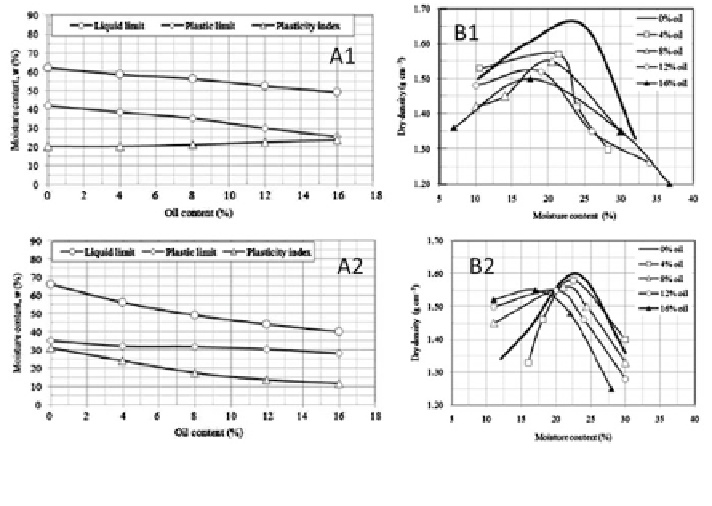Geoscience Reference
In-Depth Information
Fig. 18.50 Influence of oil contamination on A Atterberg limit, and B compaction curves for (1)
sandy loam and (2) silt loam basaltic residual soil (modified after Rahman et al.
2010
)
Ottawa sand was tested by Burckhard et al. (
2000
). In general, it was observed that
soil water retention curves for hydrocarbon-contaminated sand were different from
the retention curves of pristine Ottawa sand. At higher suction (i.e., lower pres-
sure) values, the contaminated samples had a higher holding capacity, leading to a
reduction in the soil hydraulic conductivity.
Soil water repellency caused by petroleum hydrocarbon contamination was
reported by Roy et al. (
2003
), based on a large study of 12 hydrocarbon-con-
taminated soils from Alberta, Canada. Water repellency, defined by the molarity of
ethanol droplet (MED) method, dichloromethane-extractable organics (DEO), and
total organic carbon content (TOC), were examined. All three parameter values
were significantly higher in hydrocarbon-contaminated repellent soils than in the
adjacent pristine soils. The results indicated that, in the studied sites, petroleum
hydrocarbon-induced repellency is predominantly a surface phenomenon. The fact
that most crude oil naturally contains a small fraction of dichloromethane-insol-
uble material and that this fraction tends to substantially increase once reaching the
soil (e.g., Connaughton et al.
1993
; Reid et al.
2000
), suggests that hydrocarbon-
induced repellency of soils is an irreversible change at least over human lifetime
scales.
Geotechnical and geoelectrical properties of the soil-subsurface system also
may be affected irreversibly by oil contamination. A study of geotechnical prop-
erties of sandy loam and silt loam soils of basaltic origin (Rahman et al.
2010
)
showed changes in the soil Atterberg plastic and liquid limits following contam-
ination by petroleum hydrocarbons (Fig.
18.50
). It is clearly seen that both liquid

